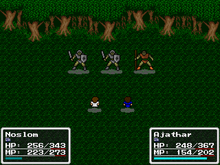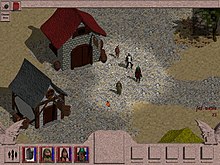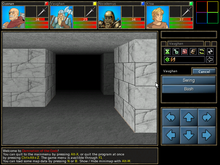Mana (games)
When Mana (from Hawaiian mana "power") is in the Fantasy (especially genre of roles - and trading card games ) a form of spiritual energy referred to the use of magic can be used of a competent character. Other names are astral energy , astral points , Magicka or magic points .
description
Note: There are different implementations and competing variants of magic systems. Therefore, the use, representation and designation may differ in individual games.
Function and application concept
In many popular games, each spell requires a certain amount of mana, which is immediately deducted from the mana pool of the protagonist of the game when used . If the required amount of mana is no longer available, the desired spell cannot be activated. The stronger a spell, the more mana it consumes. This is to prevent the player from having it too easy to defeat their opponents.
Regeneration of mana
In most fantasy and computer role-playing games, mana can be restored using certain items (e.g. mana potions). In many role-playing games (e.g. massively multiplayer online role-playing games ), such as World of Warcraft , wizards or certain races have the property of self-regeneration , so their mana gradually recovers by itself. A complete replenishment occurs in usually when the character rests completely, if possible, or through potions or the like.
Equipment (such as rings), character states (such as poisoning), enchantments, certain areas and the like can influence the regeneration speed both positively and negatively, prevent it or even decimate the mana supply. A direct influence of mana values on the life points is usually not the case.
In general, as the game progresses, a higher amount of mana is available through leveling up, and stronger spells can usually be learned.
Forms of representation
In the role-playing world, the tradition has developed to show the supply of available and usable mana in the form of a blue energy bar, which is gradually emptied when using magic. In some cases the remaining amount is indicated and calculated as a percentage . One example of this is World of Warcraft , in which - immediately after calling a spell - the selected action icon turns gray and is "recharged" within one to several seconds. The mana supply is calculated as a percentage and decreases, depending on the level of the previously called spell, by a few to a few percent. If the mana bar is empty (reduced to 0%), you can no longer cast the spells you have learned, but in many games you can use direct magic scrolls from the inventory.
In other MMORPGs, too, the blue bars are usually displayed - the life point bar is usually green or red in order to visibly separate it from the mana. Mana therefore differs from so-called Magic Points ( MP ), for which point accounts must be maintained.
Some games, such as Diablo and Sacred , also use circular mana displays, sometimes separately for individual spells that can regenerate at different speeds.
Alternatives
The role-playing set of rules Dungeons & Dragons is based on the so-called Vancian magic system, named after the author Jack Vance , who first introduced the principle in 1950 in his short story Mazirian the Magician within the fantasy book series The Dying Earth . It works completely without mana points and is instead based on memorizing spells, which, however, wear out once they are cast.
An alternative model in computer games is the so-called cooldown time , according to which a spell is only available again after a certain pause after use. Cooldowns can be combined with the mana principle.
literature
- Neil Barron, Robert Reginald : Science Fiction and Fantasy: Book Review . Wildside Press LLC, Maryland 2009, ISBN 0893706094 , 6.
- Lennart Steinke: Game programming . Hüthig Jehle Rehm, Heidelberg 2008 (2nd edition), ISBN 3826681622 , page 587.
- Jim Perry: RPG programming using XNA game studio 3.0 . Jones & Bartlett Learning, London / Toronto 2009, ISBN 1598220659 , pp. 109-117.
- Timothy Rowlands: Video Game Worlds: Working at Play in the Culture of EverQuest . Left Coast Press, Walnut Creek 2011, ISBN 1611320682 , 177.
Individual evidence
- ↑ Thomas Fortenberry: Jack Vance . In: Geoff Hamilton, Brian Jones (Eds.): Encyclopedia of American Popular Fiction . Infobase Publishing, New York 2009, ISBN 978-1-4381-1694-5 , pp. 358-359 ( online view ).


